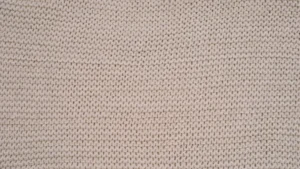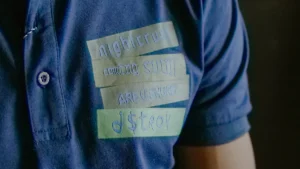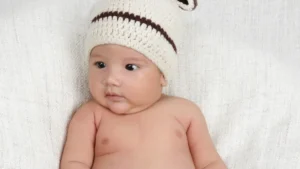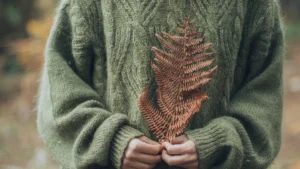Knit Cotton Fabric: Complete Guide for Apparel Brands & Buyers
Introduction
Knit cotton fabric is a cornerstone material for fashion brands and garment manufacturers worldwide. Known for its softness, flexibility, and breathability, it’s the go-to textile for T-shirts, dresses, loungewear, baby clothes, and seasonal basics. But not all knit cotton fabrics are created equal—understanding the differences in structure, fiber composition, and applications is crucial for sourcing teams and designers.
In this guide, we’ll walk you through everything you need to know about knit cotton fabric: from jersey, rib, and waffle knits to blends like cotton-spandex and sustainable organic options. Whether you’re building a basic collection or a high-performance activewear line, this guide will help you make better sourcing decisions and find the right suppliers for your business.
What Is Knit Cotton Fabric?
Knit cotton fabric refers to textiles made from cotton yarns that are looped together (rather than woven) to create flexible, stretchable material. This structure allows the fabric to contour to the body, resist wrinkles, and offer excellent comfort—making it ideal for everyday wear and casual apparel.
Knit vs. Woven Cotton: What’s the Difference?
While both woven and knit fabrics can be made from 100% cotton, their construction methods and characteristics are very different:
Woven cotton is produced by interlacing yarns in a crisscross pattern. It’s strong and stable but generally lacks stretch.
Knit cotton is made by looping yarns in a continuous manner, giving the fabric a natural stretch, more softness, and a relaxed drape.
For garments that need to move with the body—like activewear, basics, or kidswear—knit cotton is often preferred.
- 1-Piece Sampling
- 24-Hour Quotation
- 100+ Designs for Choice
- Low MOQ – 100 Units
- Save 15% with Direct Factory Pricing
- Certified, Ethical Production
Common Applications in Apparel
Knit cotton fabrics are widely used in:
T-shirts and tanks
Leggings and yoga wear (especially blends)
Baby clothing and pajamas
Sweatshirts, hoodies, and lounge sets
Lightweight summer tops and nightwear
Why B2B Buyers Prefer Cotton Knits
Versatility: Available in multiple structures like jersey, rib, waffle, and interlock.
Print- and dye-friendly: Ideal for seasonal collections or branded lines.
Scalability: Easy to source in bulk and customize in GSM, width, and finish.
Market demand: Always in high demand due to its comfort and wearability.
Main Types of Knit Cotton Fabric
Cotton knit fabrics come in many forms—each with specific properties, textures, and ideal uses. Understanding these types helps buyers choose the right material for their designs and target customers.
1. Jersey Knit Cotton Fabric
Jersey knit is the most common and versatile cotton knit. It’s smooth on one side and slightly textured on the other.
Key Features:
Light to medium weight
Naturally stretchy
Excellent drape and softness
Applications:
T-shirts, basic tops, dresses, babywear, and undergarments.
Popular Variants:
Organic cotton jersey
Cotton blend jersey with spandex for added stretch
2. Cotton Rib Knit Fabric
Rib knit fabric features vertical textured lines created by alternating knit and purl stitches. It has great elasticity and recovery.
Key Features:
Stretchy and form-fitting
Excellent for binding and trims
Higher durability in wear
Applications:
Cuffs, necklines, waistbands, body-hugging dresses, and casualwear.
Popular Variants:
1×1 and 2×2 rib knit
Ribbed cotton-spandex for better shape retention
3. Waffle and Sweater Knit Cotton Fabrics
These textured knits offer more warmth and visual interest. Waffle knits have a grid-like texture, while sweater knits mimic hand-knit styles.
Key Features:
Soft, thermal properties
Bulkier, structured feel
Enhanced texture
Applications:
Loungewear, thermals, pullovers, sleepwear, and winter collections.
4. Cotton Blends – Lycra, Spandex, and Polyester
Blending cotton with stretch fibers or synthetics enhances performance and fit.
Benefits of Cotton Blends:
Improved elasticity
Better moisture control
Wrinkle resistance
Longer garment lifespan
Popular Blends:
Cotton-spandex knit fabric
Cotton-lycra for activewear and leggings
Cotton-polyester for quick-drying and durability
5. Organic Cotton Knit Fabric
With the rise of sustainable fashion, organic cotton knits are increasingly in demand. They are grown without harmful chemicals and often come with GOTS certification.
Applications:
Eco-friendly lines, babywear, ethical fashion labels, and sustainable basics.
Benefits:
Non-toxic and skin-friendly
Environmentally responsible
Certifiable for green labeling
100% Cotton vs. Cotton Blends: Which Is Right for Your Line?
Choosing between pure cotton and blends depends on the garment type, customer base, and production budget.
| Feature | 100% Cotton | Cotton Blends |
|---|---|---|
| Feel | Natural, breathable | Stretchy, flexible |
| Shrinkage | Higher | Lower with synthetics |
| Sustainability | Better | Depends on blend |
| Application | Basics, tees, kidswear | Sportswear, activewear, fitted items |
Tip: Use 100% cotton for products where breathability and softness are top priorities. Choose blends for garments that require stretch or structure.
Buying Cotton Knit Fabric in Bulk
B2B buyers must consider more than just appearance and cost. The following factors are key when sourcing cotton knits at scale.
1. Buying by the Yard or Bolt
By the yard = more flexible for sampling and small batches
By the bolt = better pricing, often 50–100 yards/roll
2. Fabric Specifications to Review
GSM (grams per square meter): Lightweight (~140–180), Medium (~180–220), Heavyweight (>220)
Width: Typically 58–63 inches
Finish: Brushed, enzyme-washed, bio-polished, etc.
Shrinkage & stretch test data (essential for production)
3. MOQ & Lead Time
MOQ starts from 100–300 yards per color for most mills
Custom colors or finishes require longer lead times (2–4 weeks)
4. Supplier Evaluation
Check for certifications (OEKO-TEX, GOTS)
Ask for swatches or lab dips before sampling
Confirm QC processes and bulk-to-sample consistency
Knit Cotton Fabrics by Season
Summer Cotton Knits
Lightweight jersey or cotton-poly blends
Ideal for tanks, skirts, casualwear
Soft drape, breathable, dye-friendly
Example Keyword:
“cotton blend knit fabric for summer dress”
Fall/Winter Knits
Sweater knits, fleece-back cotton, waffle knit
Ideal for sweatshirts, outerwear, and loungewear
Often blended with spandex or polyester for warmth and stretch
Trends & Seasonal Color Options
Valentine Colors: Pink & Red Knit Cotton
Popular for themed capsule collections
Available in bolt or yardage for wholesale
Pre-dyed and reactive printed variants for seasonal launches
Example Keywords:
“cotton knit fabric pink red wholesale”
“valentine knit cotton fabrics bolt”
Frequently Asked Questions
Is Knitted Fabric Always Cotton?
No. While many knitted fabrics are cotton-based, they can also be made from rayon, viscose, polyester, bamboo, or wool blends. Always check fiber composition.
How to Sew Cotton Knit Fabric?
Use a ballpoint needle, stretch stitch or zigzag stitch, and a walking foot if needed. For factories, flatlock or overlock machines are standard.
What’s the Best Cotton Knit for T-Shirts?
Lightweight jersey knit (140–180 GSM) is best for most T-shirt applications, offering softness and breathability.
What Does “By the Yard” Mean for Bulk Buying?
It refers to fabric sold in linear yards. B2B buyers often purchase by bolt or kilogram depending on production needs.
Knitika- Your Reliable Supplier of Knitwear
1 Minute Quote
3 Days Sampling
13 Years Experience
50 Clients Countries
300+ Customers
1,000+ Feedbacks
30,000,000+ Knitwear Made








